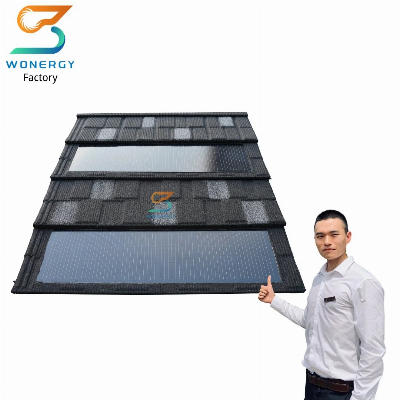Product Description Product Name BIPV Solar Panel
Powered Roof Structure Home Solar Tile Roofing
Material Tempered glass,PVB/EVA/POB, Solar Cell, Bottom
Support MODELJS35DG-5e 1/2; JS87DG-12e
1/2ColorBlackCertificationsYUV:IEC61215, IEC61730; CQC; MCS; SII;
BIS; Inmetro; SNI; CEC; JET; CL; Carton FootprintIEC 61215, IEC
61730, 3C, ISO 9001:2015, ISO 14001Effective Size
1260*480mm/630*480mmCHIP TYPEMonocrystalline siliconPEAK POWER(
Pmax )35W; 87WThe Number Of Pavement1.65 - 3.31pcs/sqmPacking26
pcs/box; 1600-1800 pcs/20' ft container loads
LIFESPAN >30YEARSWHAT IS SOLAR TILEProduct
Features1.High power generation High-efficiency crystalline silicon
cell technology, unique packaging process, higher power generation
efficiency. 2.High Security ClassA class fire protection, Class 15
instantaneous wind protection, Excellent waterproof and shock
resistance, The same life span as the building. 3.High loading
Super strong structural strength, 3 times the strength of ordinary
tiles, no fear of trampling and hail.4.Fashion and beauty Texture
color is customizable, Integrated roof design ,Coordinated and
beautiful. 5.Energy saving and thermal insulation Unique heat
dissipation structure can effectively reduce the roof temperature
by 5°C. 6.Easy installation Standardized modular unit installation,
saving time by more than 50%.STRUCTURE OF PRODUCT Detailed
PhotosSolar Roof Tiles(BIPV) Structures Glass / glass
solar panels are the most commonly used technology in energy
generating buildings. This technology so far has the highest
durability rate against harsh environmental conditions and longer
lifespan.ELECTRIC SYSTEM Product Features of
BIPV1.High power generationHighefficiency crystalline silicon cell technology, unique packaging process, higher power generation efficiency.2.High SecurityClassA class fire protection, Class 15 instantaneous wind protection, Excellent waterproof and shock resistance, The same life span as the building.3.High loadingSuper strong structural strength, 3 times thestrength of ordinary tiles, no fear of trampling and hail.4.Fashion and beautyTexture color is customizable, Integrated roof design ,Coordinated and beautiful.ACCESSORIES
Packaging & Shipping Company
Profile PROJECTS FAQ Q: Where Can You Install Building Integrated Photovoltaics (BIPV)?A:
The aluminum-zinc steel plate is strong on the other building
material. The glue spraying on the surface also adopts new
technology.soour roof tiles can be used for more than 50 years.Q :
What Types of Building-Integrated Photovoltaics(BIPV) Can You Buy?A
:BIPV products used to be exclusively for roofing. This feature
makes sense since our roofs generally receive the most direct solar
radiation. Most early innovators in BIPV technology focused on
replacing traditional roofing with panels, tiles, or shingles that
could generate renewable solar energy while protecting the home
from the elements. The impetus for this innovation stemmed from
asimple economic calculation. Suppose the average cost of a roofing
replacement in the USA costs between $5,500 and $11,500. In that
case, solar panels that doubled as a roof could essentially
"subsidize" part of the cost of going solar.BIPV products are
systems that can function as a component of the building skin or
envelope while simultaneously converting solar energy into
electricity by serving a dual purpose. Instead of attaching solar
panels to a separate roof or façade, BIPV products can offer
weather protection, thermal insulation, noise protection, daylight
illumination, and even increased safety, along with an independent,
clean source of renewable energy for your home. According to one
financial analysis, building-integratedphotovoltaic products' total
global market size will grow to an astounding $59.5 billion by
2028. As more and more companies rush to enter the BIPV industry,
the market could see a compound annual growth rate of at least 20
percent! In practical terms, this means that the options for
building-integrated photovoltaics currently available to homeowners
and builders will only continue to expand. Prices should also
continue to drop as competition stiffens and more innovative
products become available. The combination of the plummeting cost
of solar energy and innovative technologies in solar energy
production (such as thin-film technologies, solar cell efficiency,
open-circuit voltage, short circuit current, maximum effect, and
fill factor) will almost certainly continue to drive innovation in
BIPV products.Q : How Much Energy Can BIPVs Produce?A :The exact
amount of energy that BIPV products or systems can produce is
contextual. The total amount of energy will depend on several
environmental factors related to your home location, including:
Insolation/Solar Radiation: The average amount of solar radiation
your home receives, as calculated by kWh/m2/day, is the most common
way to describe the amount of solar resources in a particular area.
Check out this tool provided
Related products about 2023 Europe Green Roof Materials Photovoltaic Solution Solar Energy System
-
 Waste Tyre Plastic Recycling Machinery Machine Tire Crusher Production Line Rubber Crumb Grinding Machine Equipment Tire Shredder
Waste Tyre Plastic Recycling Machinery Machine Tire Crusher Production Line Rubber Crumb Grinding Machine Equipment Tire Shredder
-
 Stretch Plastic Blowing Pet Bottle Making Blow Molding Machine Bottles Stretch Automatic Pet Bottle Blowing Machine
Stretch Plastic Blowing Pet Bottle Making Blow Molding Machine Bottles Stretch Automatic Pet Bottle Blowing Machine
-
 Waste Plastic Pet Bottle, Water Bottle Flake, PP/HDPE/LDPE PE Film Jumbo Woven Bags Plastic Crusher Machine, Plastic Crushing Washing Recycling Machine
Waste Plastic Pet Bottle, Water Bottle Flake, PP/HDPE/LDPE PE Film Jumbo Woven Bags Plastic Crusher Machine, Plastic Crushing Washing Recycling Machine
-
 Type 2 Wall-Mounted Electric Car Charging Station 7kw /11 Kwelectric Vehicle Charging Station Home Wallbox AC EV Charger Single Phase or 3three Phase
Type 2 Wall-Mounted Electric Car Charging Station 7kw /11 Kwelectric Vehicle Charging Station Home Wallbox AC EV Charger Single Phase or 3three Phase
-
 G-View G12W Wholesale Auto Car LED Headlight Bulb High Power H13 H11 9005 H7 H4 Car LED Headlights LED Car Lights
G-View G12W Wholesale Auto Car LED Headlight Bulb High Power H13 H11 9005 H7 H4 Car LED Headlights LED Car Lights
-
 New Design Porcelain Round Plates Dinner Set for Wedding and Banquet
New Design Porcelain Round Plates Dinner Set for Wedding and Banquet
-
 China 2023 New Design Super Soft 100% Polyester Microfiber Knitted Oversized Decoration Hoodie Blanket
China 2023 New Design Super Soft 100% Polyester Microfiber Knitted Oversized Decoration Hoodie Blanket
-
 Handmade Art Creative Materials Thickened White Paper Cup DIY Disposable Handmade Colored Paper Cup
Handmade Art Creative Materials Thickened White Paper Cup DIY Disposable Handmade Colored Paper Cup



